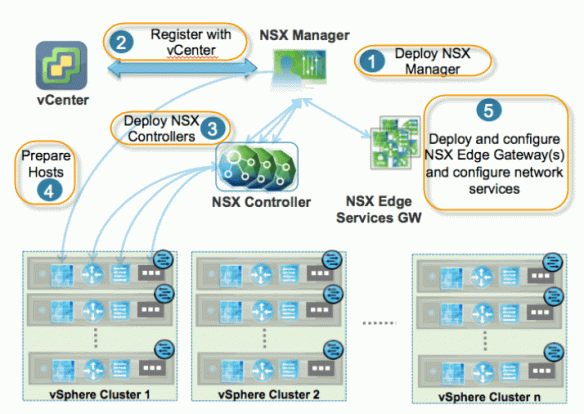I hope first part of NSX Learn series should be as per your expectation and you must have now understanding , what components of NSX are part of which plane.
Now Here is the deployment architecture…
- First you will deploy NSX Manager.
- Register NSX Manager with vCenter.
- Deploy NSX Controllers.
- Prepare hosts , which internally will install vibs.
- Then deploy Edge Gateways and Network Services.

in future posts , I will cover all above NSX component and their Deployment one by one , Lets first start with – NSX Manager.
NSX Manager: provides the centralized management plane for the NSX for vSphere architecture and has a one-to-one mapping with vCenter Server for workloads. NSX Manager performs the following functions:
- Provides a single point of configuration and the REST API entry points in a vSphere environment configured for NSX for vSphere.
- Responsible for deploying NSX Controller clusters, NSX Edge distributed routers, and NSX Edge services gateways (in the form of OVF format appliances), Guest Introspection Services, and so on.
- Responsible for preparing ESXi hosts for NSX for vSphere by installing VXLAN, distributed routing, and firewall kernel modules, as well as the User World Agent (UWA).
- Communicates with NSX Controller clusters through REST and hosts through the VMware vFabric® RabbitMQ message bus. Note that this is an internal message bus specific to NSX for vSphere and does not require any additional services to be set up.
- Generates certificates for the NSX Controller nodes and ESXi hosts to secure control plane communications with mutual authentication.
VMware NSX 6.2 allows linking multiple vCenter VMware NSX deployments together, and manage them from a single NSX Manager that is designated as primary.In such a Cross-vCenter NSX environment, there is both an NSX Manager primary instance, and one or more secondary instances. The primary NSX Manager instance is linked to the primary vCenter Server instance and allows the creation and management of universal logical switches, universal logical (distributed) routers and universal firewall rules. Secondary NSX Manager instances are used to manage networking services that are local to itself. Up to seven secondary NSX Manager instances can be associated with the primary NSX Manager in a Cross-vCenter NSX environment. The configuration of network services on all NSX Manager instances can be performed from one central location.
Note – that there is still a one-to-one relationship between an NSX Manager and a vCenter Server.
To manage all NSX Manager instances from the primary NSX Manager in a Cross-vCenter VMware NSX deployment, the vCenter Server instances must be connected with Platform Services Controllers in Enhanced Linked Mode. See the ESXi and vCenter Server 6.0 documentation for details.
An NSX manager outage may affect only specific functionalities such as identity based firewall or flow monitoring collection.
NSX manager data (e.g., system configuration, events, audit log tables) can be backed up at any time by performing an on-demand backup from the NSX Manager GUI. It is also possible to schedule periodic backups to be performed (e.g., hourly, daily or weekly). Restoring a backup is only possible on a freshly deployed NSX manager appliance that can access one of the previously backed up instances.
The NSX manager requires IP connectivity to vCenter, controller, NSX Edge resources, and ESXi hosts. NSX manager typically resides in the same subnet (VLAN) as vCenter and communicates over the management network. This is not a strict requirement; NSX manager supports inter-subnet IP communication where design constraints require subnet separation from vCenter (e.g., security policy, multi-domain management).
In Next post i will be covering How to deploy NSX Manager
Happy Learning 🙂

Very informative blog. Keep it up !
LikeLike
Thanks Vijendra…
LikeLike